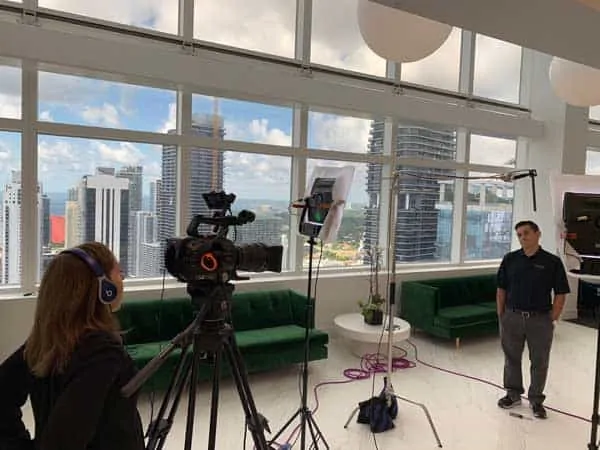The Case For Video Marketing and How It Helps SEO
Whether the business is large or small, content is king when it comes to search and being found. If you’re looking for a case for video marketing, this is it. According to OptimWise there are several factors that lead to success in being found in a search. OptimWise also shares that the items that are important and improve your chances are stuff like the quality of the content and how well the keywords have been researched and used effectively.
Other factors include newness of information, how well information answers a question being looked for, and how well items are structured and tagged. Items that can decrease success are items like useless content and stuffing keywords throughout to try to trick Google and the like.
Why Video?
Before we get into the SEO portion, it’s important to understand why video is helpful in general. When videos are relatively short, they can be more impactful than a quick paragraph. Why? Emotion. Emotions can be communicated quickly with music, visuals, movements, transitions, text on screen, verbal statements, etc.
When these come together in a video, the effect is magical. Viewers are drawn into the story, the feeling. They feel like they’re a part of the situation or problem. This is important because without emotion, you’re selling or telling. Everyone wants to buy, no one wants to be sold. Period.

Another reason for video is that Google likes it. When you type in a question you will not receive one or more (sometimes several) videos related to that question For example, doing a quick search about Doodly, we find the results are mostly video results along with information about the company that created it.
Notice the top video? That’s our Creative Director, Jenn Jager. She’s the first search result on Google and near the top of YouTube (depending on what you search). How did she do this? Read on…
Case For Video Marketing and How Video affect Search Engine Results
There are several factors that affect search (there are literally 10s and sometimes 100s of items under each of the above listed factors that affect results positively and negatively) and video is not the only one. It is one of the items that impacts rankings positively as long as certain things are in place. We know that Google (Alphabet), the world’s largest search engine, also owns YouTube as one of its brands, so having YouTube video as one type of content helps. But what type of video is helpful in getting results?
Using Google Analytics will help you determine the appropriate keywords, target audience, and real world information on your current performance. If you find an area in the analytics that pops out as a success, maximizing this information can help you determine what information you should be providing.
For example, if you determine that an area of your business is being found related to specific keywords, you might consider adding more blog posts surrounding that topic. In each blog post, you might determine a video about that topic or question might be appropriate. Why would you do that?
It has to do with your visitor’s attention span. Our experience has told us that when a video is on a page, people will more likely watch it versus read the text. If the visitor is reading the text, they may lose interest in the written word and move on (to another page or a different website).
If a visitor is watching an appealing video, they typically stay on the page to the end or near the end of the video…thus more time on the site. This will maximize your content marketing efforts by keeping them on your site longer.
Another factor related to the above paragraph is how this impacts bounce rate. By keeping a viewer on your page longer, your page (and the analytics) are telling Google that the content located on that page (or website as a combination of page) is high quality and keeps the visitor on the page. This is called lowering your bounce rate.
Wistia reported in 2016 that pages without video tracked time on page at 2.6x less than pages with video (article here). Interestingly enough, we find that pages on our website that contain video also track longer visit times. Coincidence? We think not!
Digital Marketing & Video
As a digital marketer, we recommend using video in your social media marketing efforts. If your content marketing strategy doesn’t include social media, you’re missing something. More importantly is the engagement of video on social media.
By adding video to posts, you’re also improving your engagement. Link building is typically related having links from outside websites that bring visitors to your site (and a little the other way as well), but social media is the easiest form.
Creating content, and more specifically video content is not as difficult as you might think. We work on YouTube projects regularly and use a program called Tube Buddy to determine topics and information people are looking for so we can provide content people want. If you want, you can click the link and subscribe to it (by the way, this is an affiliate link).
Whether you’re run a product or service business, providing content and information your prospective customers need and want is directly related to the success of being found online. Search traffic is one area that creating video content can help any business improve their results.
We also hear clients tell us that they don’t know what topics to create content around, such as blog topics, etc. They say they’ve created tons of content already and don’t want to repeat what they have. We think this is a mistake. When blog content repeats (with a different angle), it tells search engines that this website is more about this topic than any other…making the site an expert in the topic.
We have several case studies on our website where clients created videos for a specific purpose, brought viewers to a specific landing page, and converted them to a full-blown lead. Converting a prospect to a sale is a salespersons job. Marketing and video marketing improve the likelihood of converting to a lead and then to a sale, thus affecting the business’s bottom line.
If you need ideas on how to create content, we’ve created a blog post about it so you can create hundreds of topics. Remember to create a mix of written (text) and video (visual) posts so you can analyze which is more impactful for your visitors and which ones perform well. If you find two of 30 posts do very well, do more about those two topics. It will help your ranking. Besides, its’ what your visitors are looking for.
Need help? Give us a call!

























